 |
 |
|
|
|
  |
Landmarks and Historic Locations
| Monuments within the ward••••• |
The Monument of Soshoko
1-1, Fukushima-ku, Osaka |
The Monument of Soshoko was created by taking one character each from the names of Matsumoto Keido, Matsumoto Iyama and Okashika Mon who established a Kanji School in 1861 near the end of the Tokugawa Shogunate on the western side of the north end of the Tamino Bridge. They were advocates of anti-foreign sentiment and it was rumored that meetings were being held here to overthrow the Government. They were then deemed to be dangerous by the Osaka Magistrates office, and in 1862, after only 6 months, the school was closed down.
The Monument of Soshoko was created in 1943 by the association of people from Nagasaki prefecture lead by Hashimoto Chozaburo, the first Chancellor of Osaka Imperial University who was taught at this Kanji school by Matsuyama Iiyama. Unfortunately it is currently unavailable for viewing.
|
 |
The Birthplace of Matsuse Seisei
4-10-17, Ebie, Fukushima-ku, Osaka |
Matsuse Seisei was born the eldest son of a charcoal and firewood dealer from Semba in April 1869. His real name was Yasaburo and following graduation from Kitahama Upper Primary School, he did an apprenticeship and peddled fabrics. After this however, he joined the Osaka branch of Daiichi Bank. At the age of 28 he began learning haiku poetry and following submissions to "Hototogizu" (a haiku magazine), he met with Shiki Masaoka, quit his job at the bank, and moved to the capital as an editor of "Hototogizu". In 1900 he moved back to Osaka and joined the Osaka Asahi Newspaper in charge of the Asahi Haidan, a column for selected haiku. The following year, he launched a haiku group called "Takarabune" (later changed to Kencho) and was president for its entirety. He also published haiku collections such as "Matsunae" and "Tsumaki" etc. Matsuse Seisei's haikus were brilliant in his clarity in subjectivity of human relationships, and he was known as Kansai's Takahama Kyoshi.
At the end of 1906, he moved from his birthplace of Ogawa ward (Kitahama 4-chome of in Chuo-ku) to near the Yasaka Shrine where he lived until 1921. This is where the Matsuse Seisei Monument was erected and stands today. Matsuse Seisei passed away in 1937 at the age of 69. This monument with the words "Seisei Sensei" enscirbed was erected inside the grounds of the Nankeiji Temple at his 13th Memorial by his students from when he lived in Ebie.
|
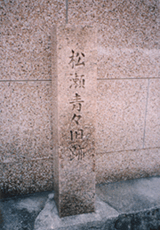 |
The Monument of Sakaranomatsu
2-2-4, Fukushima-ku, Osaka iIn front of Geto Mansion Domile Dojima" |
According to Sakaro, chapter 11 of Tale of Heike, in February of 1185, Minamoto Yoshitsune left Kyoto and crossed Settsu to attack Heishi and attempted surprise attacks by boat on Yajima in Shikoku from Fukushima.
Minamoto Yoshitsune had little experience in attacking from boats, and it was proposed at a meeting by Kajiwara Kagetoki, a staff member that "not only an oar but a rudder (a sakaro) should be attached to the front of the boat for ease in moving backwards and forwards". But Yoshitsune said "Nothing good can come from thinking of retreat before you even start. We shall fight just with oars at the stern of the boat." So they fought without rudders attached, and it is said that this discussion was held here.
According the topographical map "Settsuu meisho zue" from the Edo Period, there stood a pine tree older than a thousand years, with a trunk like a snake. This is known as the Pine Tree of Sakaranomatsu. It is said that its roots were around 7 feet long at the beginning of the Meiji Period, but that these roots were destroyed in "Kita no Taika" of 1909. In April 1915, the Fukushima Historical Association erected the Monument of Sakaranomatsu, but it was temporarily lost in the Osaka air raid campaign during WW2 on March 13, 1945, It was however rediscovered in 1948, when a freight company was leveling the ground on which it was, and it was re-erected on the footpath outside that company, and moved to its present position in May of 1974 by local volunteers.
|
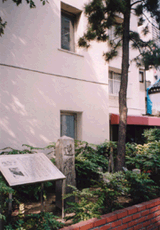 |
The Birthplace of Fukuzawa Yukichi
1-1, Fukushima-ku, Osaka |
Known for his famous words "The heavens do not create people above others, nor people below others", Fukuzawa Yukichi was born in a compound with a storage facility of the Bizen nakatsu province in Osaka (the site of the old Osaka University Hospital" in 1835, the youngest of 5 children of Fukuzawa Hyakusuke, a samurai from Nakatsu, with 1 older brother and 3 older sisters.
In June of 1837 when Fukuzawa was 18 months old, he father died, and he retuned to Nakatsu with his mother and sisters, where he stayed until the age of 19. This house in Nakatsu City in Oita Prefecture is honored as being the place associated with Fukuzawa Yukichi, and is currently open to the public with the Memorial Hall built alongside it.
Fukuzawa Yukichi learned Confucianism from a young age, in which he was gifted, but following a recommendation from him brother, he went to Nagasaki in 1854 and began studying Dutch. The following year he returned to Osaka and joined Ogata Koan's home-school, and stayed until he became headmaster of it. Following this, he went to Edo on an order from his clan, and it was there he opened a Dutch language school at the residence of Okudaira from the Nakatsu Clan. As well as being a disciple to Okudaira, he began to study English on his own. With his command of the English language, he was sent with the first mission to the US on the Kanrin-maru, a Japanese ship-of-war. After another mission in which he visited 6 countries in Europe, in 1868, Fukuzawa established Keio University. He is also famous as a representative thinker of his era through books such as "Gakumon no Susumekata" etc. This monument indicating Fukuzawa's birthplace sits on the location of the old Osaka University Hospital.
|
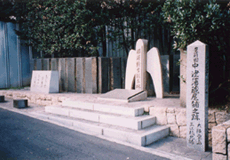 |
Shrines within the ward•••••
Yasaka Shrine
6-4-2, Ebie, Fukushima-ku, Osaka |
It is not known exactly when this shrine was first built, but there are stone lanterns with the names of the Tenji (around 1124), and Oharu Periods (around 1126) engraved in them, and according to old village records it underwent the Sougetusyaden reconstruction in 1383, which would make it extremely old. Originally it was called Gozu-tenou Shrine, but was renamed at the beginning of the Meiji Period. It is believed that the village was made due to reclamation of the land due to nearby sandbars called Sagi-shu and Ebie-shu etc, and the shrine was built as a tutelary shrine. In 1570, when Oda Nobunaga attacked Ishida Hongan Temple in order to attack Noda Castle's Miyoshi family, it is recorded that they prayed here for victory, gave orders to the leading general Araki Murashige, and noted the positions of their men and weapons.
Within the grounds lays a monument to Matsuse Seisei who was active in the haiku world in Kansai near the end of the Meiji Period, In 1887, he wrote a haiku wishing for a snow-covered Mt. Rokko above blossoming meadows; "The blossoms and the snowy mountain to the North".
On the evening of 15th of December every year "Miyazashinnji" is held privately according to the traditional rites. This became an Osaka Prefecture Intangible Cultural Asset in January 1972.
The "Miyazashinnji Kyou" dates back to before 1781, and was begun at about the beginning of the modern age. This "Shinji" has inherited the characteristics of an exclusive "Miyaza" and exclusiveness of the "Za", and it is called the Silent "Shinji" as its rites etc were handed down by word of mouth to prevent them getting out to the plebs.
|
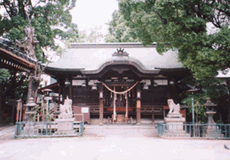 |
Fukushima Temman Shrine
2-8-1, Fukushima-ku, Osaka |
Head south on the Naniwa-suji from JR Fukushima station over the National Highway Route 2, and it is located on the west side of the next corner. Those worshipped as deities include Sugawara no Michizane, and "Ookuninonushinomikoto" "Kotoshironushi" etc.
This Tenman Shrine is often called "KaminoTenjin". "NakanoTenjin" and "ShimonoTenjin" also used to exist as part of the "Three Shrines", but Naka-no-Tenjin was burnt to ruins in the Pacific War where its remains laid in Fukushima 4-chome (next to the southern exit of Osaka Kosei Nenkin Hospital". But when it was reconstructed in the September after the "Kita no taika" of 1909, only a memorial stone and a stone wall were left. In the past, "Funatogyo" summer festivals for the Tenman gods representative of Osaka were held downstream of the Dojima River, and pikes were thrown downstream from Tenjin Bridge, and the location of the "Anguu" was where the pikes washed ashore. There is an old legend which says that the locations of the "Three Shrines" are where the remains of those festivals lay.
Sugawara no Michizane, and "Sukunahikonanomikoto" are worshipped as deities at ShimonoTenjin just as at NakanoTenjin, and this remains as a Tenjin Shrine at Tamagawa 1-chome.
|
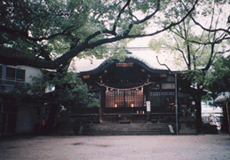 |
Ebisu Shrine
4-1-1, Tamagawa, Fukushima-ku, Osaka |
Popularly know as "Noda no Ebessan", it is not known exactly when Ebisu Shrine was built. However, within the grounds there are granite stones with "Ebisu no Miya" carved into the front, and the date March 1115 on the side. The stones themselves were erected afterwards, but it is thought that the shrine itself was built around this time. From ancient times, the god Ebisu has been revered at the god of fishing and the area around the shrine was called Naniwa Yasojima, and was a centre of the fishing industry. On the 10th of January every year many worshippers come to Ebisu, and he has also gathered many followers as the local god due to big parades during the summer festival with "Danjiri", taiko drums, and "Taihoko"etc
|
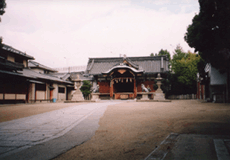 |
Minami Ltd., a Nationally Registered Cultural Asset. "Building"
5-17-7, Fukushima-ku, Osaka |
Sitting on the National Highway Route 2 near JR Shin-Fukushima Station, the building of Minami Ltd. was built in 1934 and is a Registered Cultural Asset.
A building is recognized as a Registered Cultural Asset after it stands for 50 years and "contributes to the historical aspect of Japan". The reinforced Minami building which has 2 floors and one underground floor has 4 lonic style columns in the front which gradually curve into the back, giving it a perceived depth.
The entrance has circular eaves with engravings, and at the top of the columns inside the building are gorgeous Corinthian style decorations.
|
|
The Site of Noda Wisteria- One of Osaka City's Honored Monuments
2-2-7 ,Tamagawa, Fukushima-ku, Osaka |
Approximately 500 meters south of Noda Hanshin along the new Naniwa-suji lies the Tamagawa-South Park. To the east of that is the "Hokora" of Kasuga Shrine, and inside that, standing approximately 1,2 meters tall is the Site of Noda Wisteria Stone Monument.
Wisteria has grown in this area for generations. In 1364, the 2nd Shogun of the Muromachi Shogunate, Ashikaga Gizen visited this area to see the wisteria, and wrote "The purple wisteria of Tamagawa river in Noda from ancu\ient days still beautiful". Also in 1594, Toyotomi Hideyoshi came here accompanied by Sorori Shinzaemon and others to see the wisteria and it is said that they had a tea ceremony For a time in the Edo Period Noda wisteria died off somewhat, but it has resurged again since then to be ranked up there as a national beauty spot with "Yoshino's Sakura and Takao's Autumn Leaves."
The name "Noda wisteria" comes from Dr. Makino Tomitaro, a botanist from the Meiji Period, who called it such. A characteristic of Noda wisteria is that the vines twist to the right, in contrast to the vines on regular mountain wisteria which twist to the left.
Since the Meiji Period, Noda wisteria started to die away, and for a while it was almost extinct, but the Fukushima Lions Club has been carrying out recovery efforts, and in 1971 succeeded in grafting an old wisteria bush remaining in FUJI Clan. Because Noda wisteria can be seen in spring at many places around the ward, and it has been designated as Fukushima's Official Flower.
|
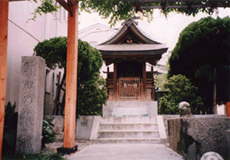 |
The Site of Noda Castle Osaka City's Honored Monument
4-11-15, Tamagawa, Fukushima-ku, Osaka |
Near the "Tamagawa" exit out of Sennichimae subway, (in the shrubbery in front of the Asahi Bank) stands the monument of the Site of Noda Castle. This was erected by Osaka City in March of 1990, and on the left-hand side of the monument is engraved "this area, known as "Saka no Uchi" was a key position in the Warring States Period and Oda Nobunaga's attack on Ishida Hongan Temple".
Noda Castle was built around 1531, and it is thought that it was later renovated by the Miyoshi family which dominated the Kinki Prefecture. In 1570, Oda Nobunaga invaded Ishida Hongan Temple which was the start of the "Ishiyama Battle" which was to last for 10 years. In response to Oda's army which had surrounded Ishida Hongan Temple, the Miyoshis, who had formed an alliance with Ishida Hongan Temple, entrenched themselves into Noda castle and fought from there, but Oda had a strong army and the Miyoshis eventually had to retreat. In 1578, the temple again became a key position of Oda's army when he fought "Mouri Suigun". After this however, the history of this temple was lost, and even today the whereabouts of its remains are unknown. It is thought that the temple used to stand in this area due to "Yumiba", and "Saka no Uchi" etc, place names in the Tamagawa area from the beginning of the Meiji Period,
|
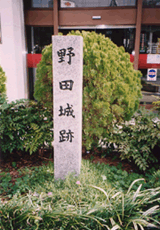 |
|
 |
|
 |
|
 |
